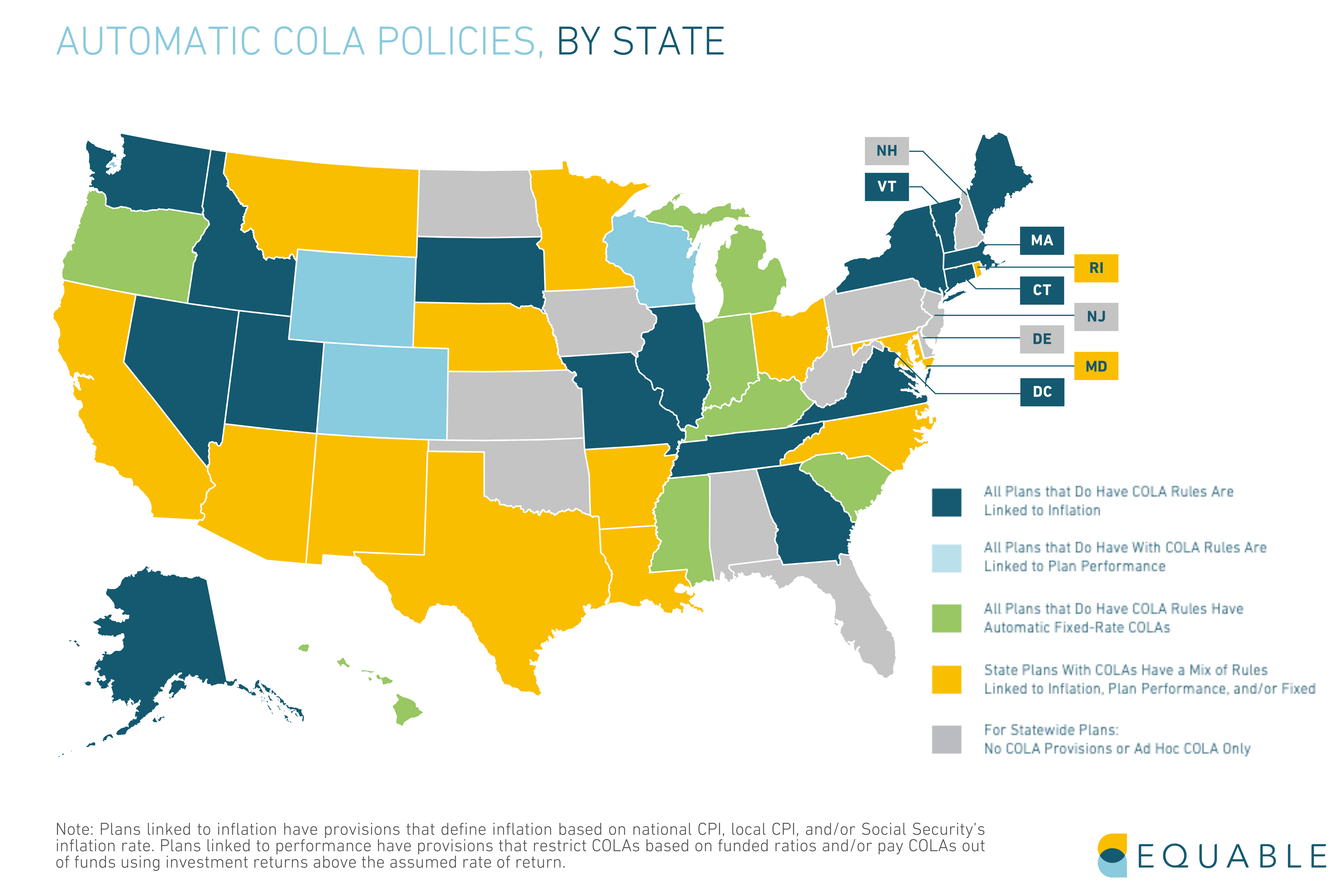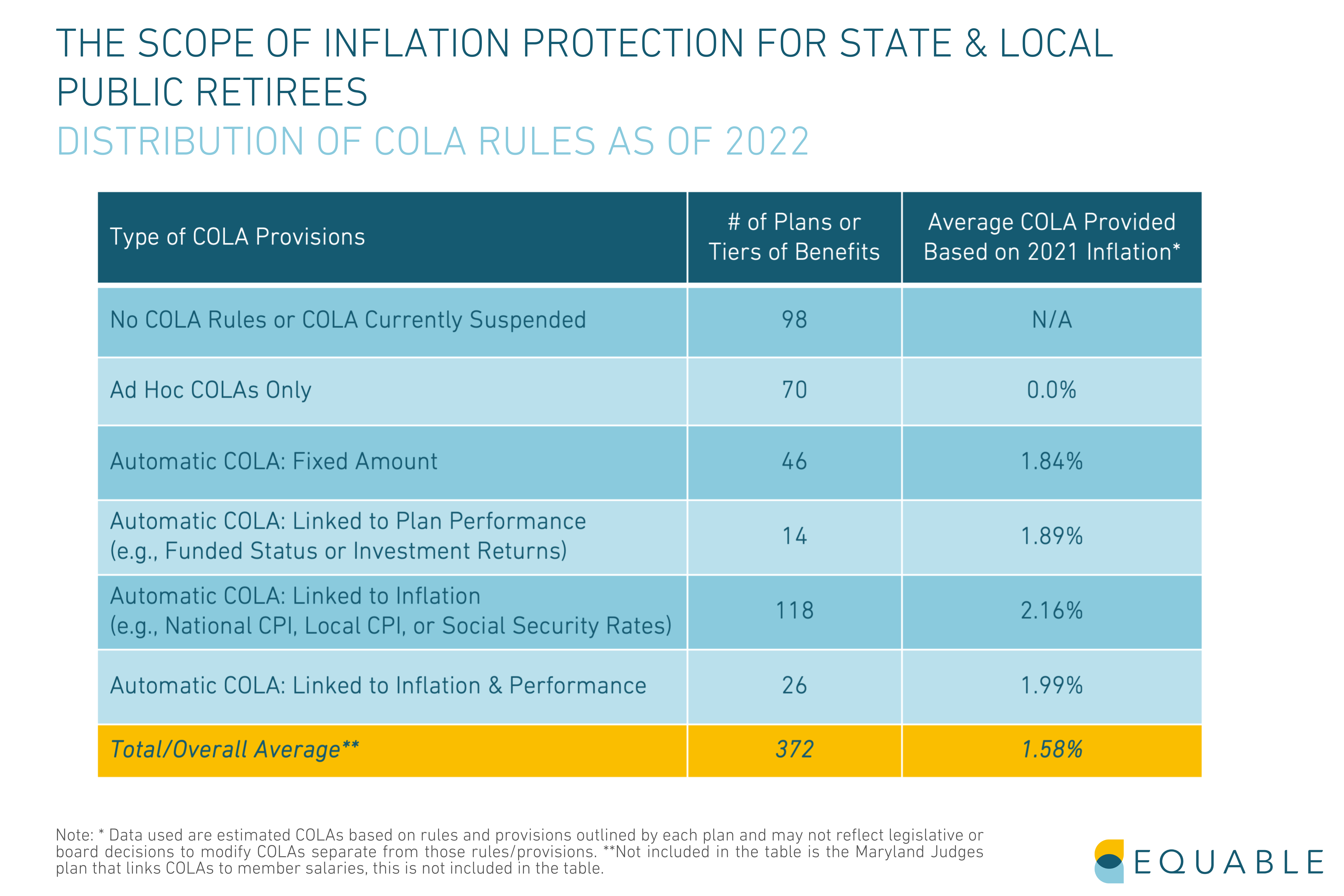Retirees with a pension from state or local governments were made a promise: guaranteed income for the rest of their lives. But in a number of states, that doesn’t necessarily mean a financially secure retirement — if pension income doesn’t keep up with inflation, then it is not really a secure retirement income. Unfortunately, there isn’t universal cost-of-living adjustment coverage for retired teachers, firefighters, city workers, and other public workers with pensions. So who is protected from inflation, and by how much? Here is what you need to know about if public workers’ pensions are protected from inflation in America.
Is Your COLA Automatic?
The map above reflects information about statewide Public Worker Retirement systems and their Protection From Inflation (such as “CalPERS” in California) or large city systems (like New York City’s Employees’ Retirement System).
The colors reflect the varied range of cost-of-living adjustment (COLA) policies, depending on the state paying out pensions — sometimes this protection is called a “post-retirement increase” or “post-benefit increase” instead.
If you retired from a state in blue or green then you likely have some level of COLA protection:
- Dark blue means that all of the state’s pension plans adjust retirement income based on actual annual inflation, usually up to some limit like a maximum annual adjustment of 2% or 3%; there are a few pension plans that will match the actual inflation rate for a given year if the previous few years have had low inflation.
- Light blue means that all retiree pension benefits will get adjusted for inflation to some degree, but only if the underlying pension fund has sufficient resources to payout those increased rates. For example, in Colorado retirees can get a COLA up to 2%, but if the state is not ensuring a sufficient level of contributions into the pension fund then that maximum COLA rate gets reduced.
- Green means that any of the state pension plans that do offer COLAs are providing fixed rates that they adjust retirement benefits for that automatically happen each year. The rate is prescribed ahead of time, which means in some years it will be greater than inflation and in other years less than inflation.
If you retired from a state in yellow or gray then you should definitely double check the COLA rules from your specific pension plan:
- Yellow means that there is a mix of COLA coverage in the state. For example, Arizona police and firefighter retirees have COLAs that are up to 2% increases each year, depending on local inflation levels and the availability of resources to pay those increases; but Arizona’s retired teachers, state workers, or municipal employees don’t have any COLA protection on their benefits when inflation hits.
- Gray means that among the statewide retirement systems in the state, there are no COLA benefits offered at this time. In some cases this might be because of a COLA freeze (like in Oklahoma or New Jersey), or there might be city pension plans that offer inflation protection even if the state pension fund doesn’t (like Florida). But there may simply be no built-in provisions for inflation protection (like Iowa or Alabama).
Three Types of COLA Frameworks
There are generally three policy frameworks for those who do have automatically granted COLAs that protect public worker pensions from inflation:
- Fixed-Rate COLAs: A pre-fixed specific percentage of benefit increase (or minimum dollar amount).
- COLAs Linked to Inflation: A percentage increase to benefits based on the national consumer price index (CPI), a local CPI, or the Social Security inflation rate. The actual amount is typically “up to” a maximum rate, such as 2% or 3%.
- COLAs Linked to Plan Performance: A percentage increase to benefits that is dependent on the funded ratio and/or investment performance of the underlying pension plan. The actual amount is also typically “up to” a maximum rate, but that maximum rate is determined by the specific provisions around plan performance. For example, the maximum COLA rate may be cut in half or suspended if the pension fund is under 80%.
Some state pension funds have inflation adjustments linked to both inflation and pension plan performance.
Other states do pay out COLAs in certain years, but only if the legislature authorizes the benefit adjustment. These are called “ad hoc” COLA benefits because they aren’t legally required and they are heavily dependent on local politics and legislative budgets.
The table below shows the total number of pension plans (or tiers of pension benefits within the same plan) that offer COLAs of different kinds. The table also shows the average COLA that was paid out in 2021 based on the underlying plan provisions.
Do COLAs Really Keep Up With Inflation?
The majority of public pension COLAs have maximum annual increases of 2% or 3%, which is typically sufficient to keep up with inflation and protects public worker retirees protected from inflation. Over the past decade, the average annual rate of inflation has been less than 2%. But in the context of 2022, inflation rates are significantly higher and most COLA rules will not be keeping up with inflation.
There are some pension plans that ensure the purchasing power of pension income doesn’t fall too far behind inflation. For example, CalSTRS has rules for offering modest annual COLAs. However, if those fail to keep up with inflation, then they will adjust benefit values for certain retirees at a faster rate. Specifically, they have promised that the value of pension income will at least maintain 85% of the purchasing power it had in the year when the pension benefit was first issued. This is a very reasonable level of benefit protection, but unfortunately for public workers it is not common.
Compounding versus Non-Compounding
When COLAs are paid out, there are two basic ways that the underlying benefit is adjusted:
- Compounding Benefits: This means that the base benefit gets permanently adjusted and any future changes to benefits are added on top. For example, someone with a $40,000 pension that gets a 2% COLA will have their base benefit increased to $40,800. The next year, if inflation means a 1.5% COLA, then the adjustment is calculated based on the new, higher number. So in this case, the benefit would increase to $41,412.
- Non-Compounding Benefits: This means that all inflation adjustments are based on the original pension benefit value. Each year that benefits are increased you get to keep the adjustment from the previous year, but the percentage increase is based on your original pension. For example, someone with a $40,000 pension that got a 2% COLA would see $800 added on top for a total pension of $40,800. The next year, a 1.5% COLA would be calculated on the original $40,000 pension and $600 would be added on top for a total pension of $41,200.
For more on why COLAs are important for retirement security, see this article from 2019.
To learn more about the specifics of your public retirement plan, check out our interactive database of Retirement Security Scorecards.



